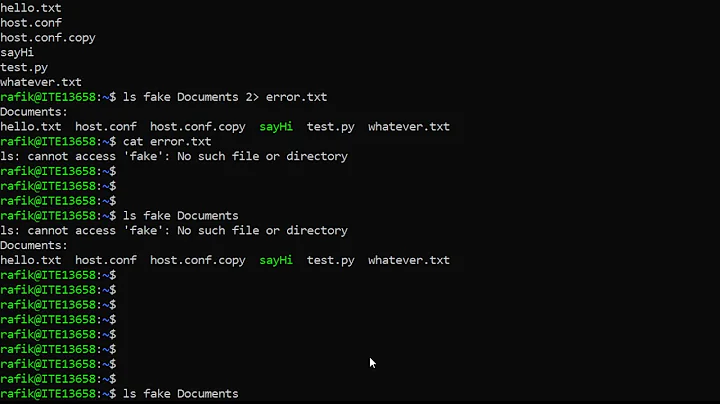Redirecting Standard Output And Standard Error to One File
Redirections are processed from left to right. When you execute:
ls -l /bin >ls-output.txt 2>&1
the shell performs approximately the following operations internally:
fork(); // Then in the child process:
fd = open("ls-output.txt", O_WRONLY | O_CREAT | O_TRUNC, 0666);
dup2(fd, 1);
close(fd);
// 2>&1
dup2(1, 2);
Then it executes the ls -l /bin command with these descriptor attachments in place. Since you redirect stdout to the file first, the redirection of stderr inherits that redirection.
If you were to write
ls -l /bin 2>&1 >ls-output.txt
The order of operations would be inverted:
// 2>&1
dup2(1, 2);
// >ls-output.txt
fd = open("ls-output.txt", O_WRONLY | O_CREAT | O_TRUNC, 0666);
dup2(fd, 1);
close(fd);
This connects stderr to the original stdout, which is likely to be the terminal. Then it redirects stdout to a file; this has no effect on stderr.
Related videos on Youtube
Aman
Updated on September 18, 2022Comments
-
Aman over 1 year
I have come to understand that we have two methods of redirecting both stdout and stderr to the same file. The first method is:
ls -l /bin > ls-output.txt 2>&1As the author of this book states: Using this method, we perform 2 redirections, first we redirect stdout to ls-output.txt and then we redirect stderr(file descriptor 2) to stdout(using file descriptor 1).The order of redirections is important.
ls -l /bin 2>&1 >ls-output.txtwould redirect stderr to screen.My question is: Like in many programming languages, was the command designed with some associativity and precedence rules in mind and how do we read the command while writing it on screen? and what is the sequence of the backend execution of the command?
Here's what i think about the execution sequence: First, the command
ls -l /binsends its output to stdout and error to stderr(any one of those). Then, the stderr is redirected to stdout.(if there is any error, eg: ifls -l /binnis used) Now, the stdout stream contains one of the two(either output or error) which it then redirects to the file ls-output.txt-
 muru over 9 yearsThe redirection happens before
muru over 9 yearsThe redirection happens beforelsever starts. It's handled by the shell. See, for example, the Bash Hackers Wiki, or the links in this SO question. -
Barmar over 9 yearsYour question asks about standard output and standard error. Why does the title refer to standard input?
-
Aman over 9 years@Barmar, sorry it was a typo, thanks for pointing it out :)
-
-
Chris over 6 yearsSome extra info: dup2(int oldfd, int newfd);
dup2()makesnewfdbe the copy ofoldfd, closingnewfdfirst if necessary... .




